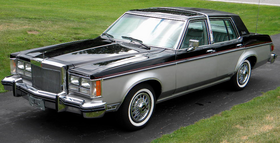
Lincoln Motor Company, or simply Lincoln, is the luxury vehicle division of American automobile manufacturer Ford. Marketed among the top luxury vehicle brands in the United States, Lincoln was positioned closely against its General Motors counterpart Cadillac. The division helped to establish the personal luxury car segment with the 1940 Lincoln Continental.

Mercury was a brand of mid-priced automobiles produced by American manufacturer Ford Motor Company between 1938 and 2011 with 1939 being the first model year. It stood as its own line within Ford until 1945, and thereafter formed half of Ford's Lincoln-Mercury Division. Created by Edsel Ford in 1938 to bridge the gap between the Ford and Lincoln model lines, its principal competition was General Motors' Buick and Oldsmobile divisions, and Chrysler Corporation's DeSoto and Chrysler brands.
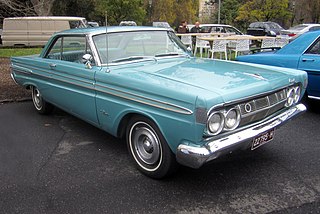
The Mercury Comet is an automobile that was produced by Mercury from 1960–1969 and 1971–1977 — variously as either a compact or an intermediate car. In its first two years, it was marketed as the "Comet" and from 1962 as the "Mercury Comet".

The Lincoln Town Car is a model line of full-size luxury sedans that was marketed by the Lincoln division of the American automaker Ford Motor Company. Deriving its name from a limousine body style, Lincoln marketed the Town Car from 1981 to 2011, with the nameplate previously serving as the flagship trim of the Lincoln Continental. Produced across three generations for thirty model years, the Town Car was marketed directly against luxury sedans from Cadillac and Chrysler.
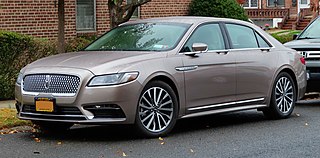
The Lincoln Continental is a series of mid-sized and full-sized luxury cars produced between 1939 and 2020 by Lincoln, a division of the American automaker Ford Motor Company. The model line was introduced following the construction of a personal vehicle for Edsel Ford, who commissioned a coachbuilt 1939 Lincoln-Zephyr convertible, developed as a vacation vehicle to attract potential Lincoln buyers. In what would give the model line its name, the exterior was given European "continental" styling elements, including a rear-mounted spare tire.

In the automotive industry, rebadging is a form of market segmentation used by automobile manufacturers around the world. To allow for product differentiation without designing or engineering a new model or brand, a manufacturer creates a distinct automobile by applying a new "badge" or trademark to an existing product line.

The Ford Fairmont is a model line of compact cars that was manufactured by Ford from the 1978 to 1983 model years. The successor of the Ford Maverick, the Fairmont marked the third generation of compact sedans sold by Ford in North America. Initially slotted between the Pinto and Granada within the Ford line, the Fairmont was later marketed between the Ford Escort and Ford LTD. In contrast to its predecessor, the model line was offered as a two-door notchback sedan, two-door coupe, four-door sedan, and five-door station wagon. Though never sold as a Lincoln, Mercury sold a divisional counterpart of the Fairmont as the Mercury Zephyr.

The Dodge 400 was a mid-size car built by Dodge. It was similar to the Chrysler LeBaron of the same era. The 400 was introduced for the 1982 model year but renamed and merged into the Dodge 600 lineup just two years later. An improved version of Chrysler's K-cars, it was called the Super K platform.

The Mercury Monarch is a compact automobile that was marketed by the Mercury division of Ford from the 1975 to 1980 model years. Designed as the original successor for the Mercury Comet, the Monarch was marketed as a luxury compact vehicle; alongside its Ford Granada counterpart, the Monarch expanded the segment in the United States as automakers responded to the 1973 fuel crisis.

The Ford LTD is a range of automobiles manufactured by Ford Motor Company for the 1965 to 1986 model years. Introduced as the highest trim level of the full-size Ford model range, then the Galaxie, the LTD offered options and features that had previously been reserved for more luxurious Lincoln and Mercury models. The largest vehicle produced by Ford in North America for most of its production, the LTD was joined by the intermediate Ford LTD II from 1977 to 1979; the LTD II served as the replacement for the Torino/Gran Torino range. At various times throughout its production, the LTD range included two- and four-door pillared and hardtop sedans, a two-door convertible, and the Country Squire five-door woodgrain station wagon.

The Cadillac Fleetwood Brougham is a luxury car manufactured by Cadillac from 1977 through 1986. In 1987, the Fleetwood Brougham name was shortened to simply Brougham, with production continuing through 1992 with only minor updates.

The Ford Custom is an automobile which was produced by Ford in the United States, Canada and Australia in certain years from 1949 to 1981.

The Mercury Colony Park is an American luxury full-size station wagon that was marketed by the Mercury division of Ford Motor Company between 1957 and 1991. Distinguished by its simulated wood-grain paneling, the Colony Park was marketed as either the premium-trim or the sole full-size station wagon offering of the division. Following the 1960 demise of Edsel, full-size Mercury vehicles shared bodywork with Ford; the Colony Park served as the counterpart of the Ford Country Squire through 1991.

The Ford LTD II is an automobile produced and marketed by Ford Motor Company between 1977 and 1979 in the United States and Canada. Deriving its name from the full-sized Ford LTD model line, the intermediate LTD II consolidated the Ford Torino and Gran Torino model lines, with the Ford Elite replaced by the Ford Thunderbird. Offered in a two-door sedan, four-door sedan, and station wagon, the LTD II also served as a basis for the final generation of the Ford Ranchero coupe utility.
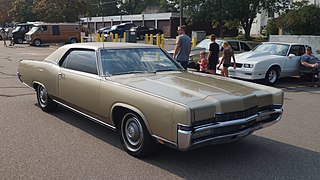
The Mercury Marquis is a model line of automobiles marketed by Mercury from 1967 to 1986. Deriving its name from a French nobility title, the Marquis was introduced as the divisional counterpart of the Ford LTD; four generations of the two model lines were paired through rebranding. Initially slotted as the flagship Mercury full-size range, the Marquis would serve as the basis for the later Mercury Grand Marquis.

The Lincoln Premiere was a luxury car model sold by Lincoln in the 1956 to 1960 model years. Positioned below the company's Continental Mark II coupe during 1956–1957 and above the Capri which it shared from 1956 to 1959, it was produced in 2 and 4 door versions which could both accommodate up to six people.
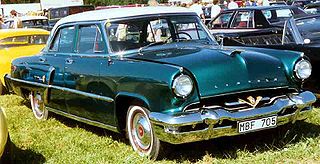
The Lincoln Capri is an automobile that was sold by the Lincoln division of Ford Motor Company from 1952 until 1959. A full-size luxury car, the Lincoln Capri derives its name from an Italian island in the Gulf of Naples. Introduced as a premium trim variant of the two-door Lincoln Cosmopolitan, the Capri was introduced in 1952 as a stand-alone model line serving as the premium Lincoln. With the introduction of the Lincoln Premiere, the Capri replaced the Cosmopolitan as the standard Lincoln product line.

The Continental Mark VI is a full-size luxury car that was produced by Ford Motor Company from 1980 to 1983. The fifth generation of the Mark series, the Continental Mark VI introduced several changes to the model line. Again marketed and serviced by the Lincoln-Mercury division, the Mark VI served as the flagship of the entire Ford Motor Company model line, slotted above the Lincoln Town Car.
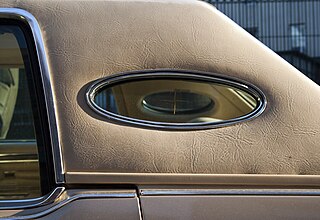
An opera window is a small fixed window usually behind the rear side window of an automobile. They are typically mounted in the C-pillar of some cars. The design feature was popular during the 1970s and early 1980s and adopted by domestic U.S. manufacturers, most often with a vinyl roof.

The North American version of the Ford Granada is a range of sedans that was manufactured and marketed by Ford over two generations (1975–1982). Developed as the original successor for the Ford Maverick, the Granada shares its name with Ford of Europe's flagship sedan. The model line was marketed as a luxury compact vehicle, expanding the segment in the United States.
